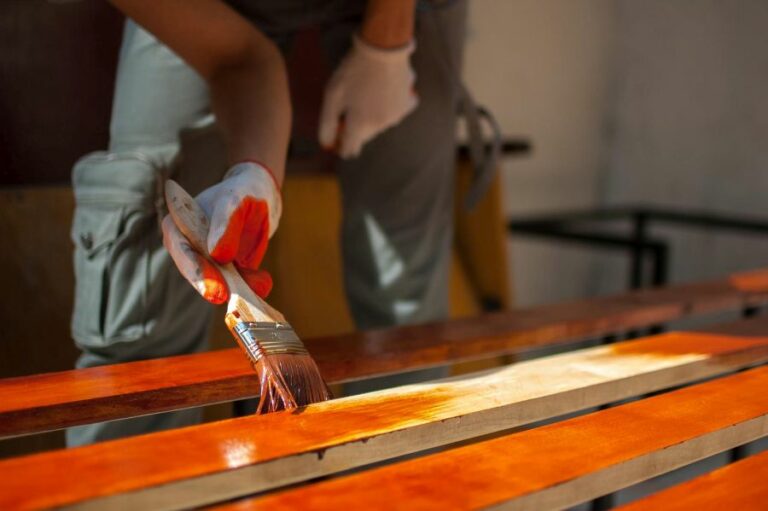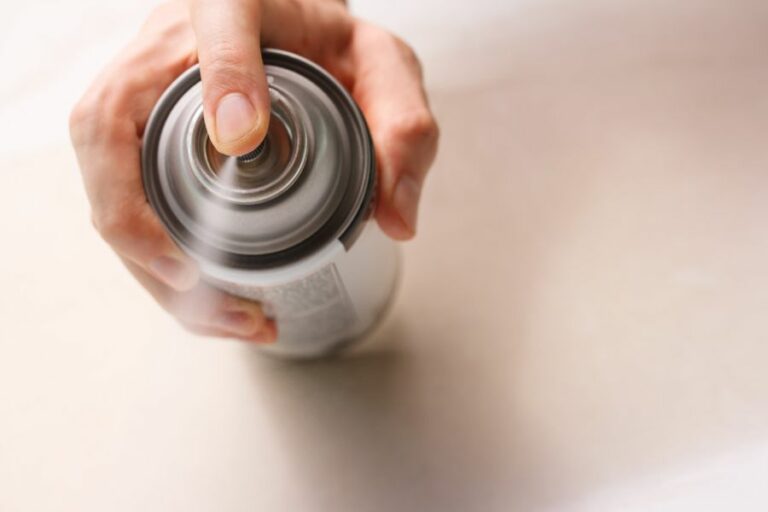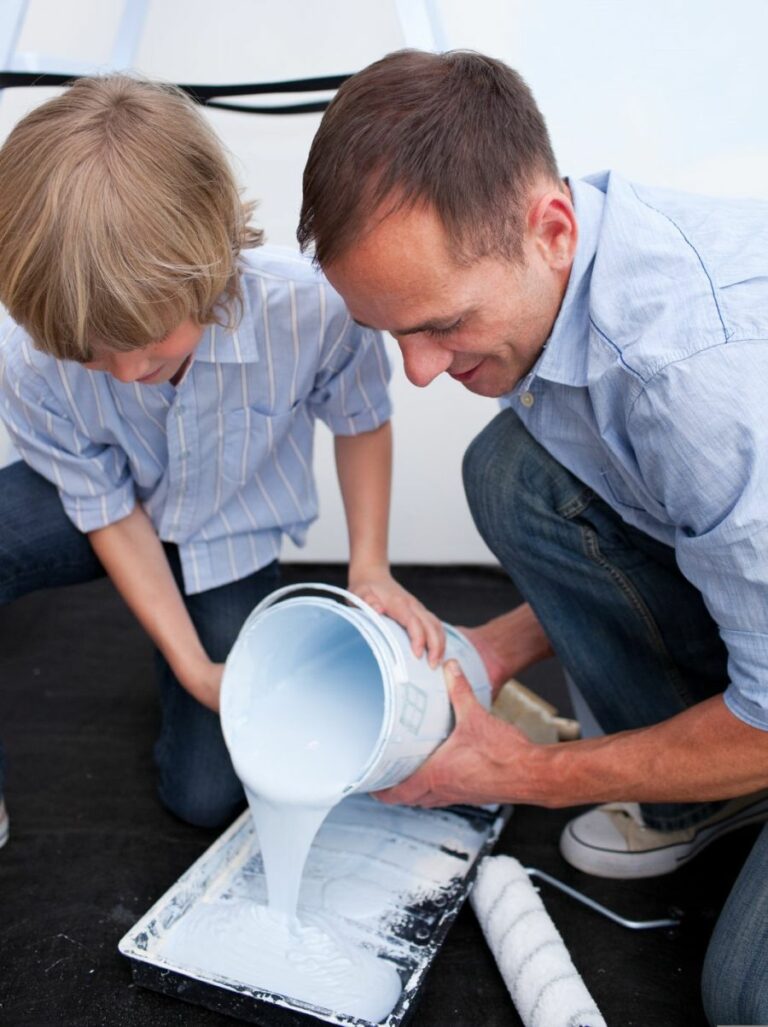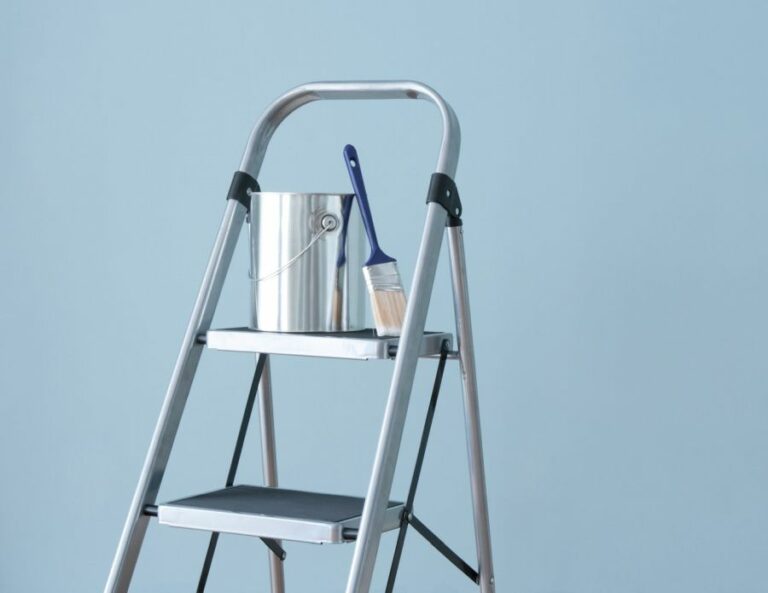How To Paint Outdoor Tiles, 25 Things You Should Know
Painting outdoor tiles can transform the look of your space, extending the life of your flooring and boosting your home’s curb appeal. However, it can be tricky knowing where to start and which materials to use. We have the expert tips and guidance you need to dive into this DIY project and achieve stunning results. With the right approach, you, too can master this creative task and add your personal touch to your outdoor area.
How to paint outdoor tiles:
To paint outdoor tiles, first, assess their condition and clean them thoroughly. Repair or replace any damaged tiles. Choose paint suitable for your tile material and outdoor use. Apply a primer designed for outdoor tiles, then paint in even, smooth strokes, applying multiple coats. Finish with a clear, exterior-grade sealer. Maintain the painted tiles by cleaning and touching up as needed.

Ready to give your outdoor tiles a fresh look? Discover our easy-to-follow guide on how to paint outdoor tiles, ensuring a beautiful and durable finish. Keep reading to uncover expert tips and tricks for a successful transformation!
Contents
- 1 A Comprehensive Guide on Painting Outdoor Tiles
- 2 Is it Possible to Apply Paint on Exterior Tiles?
- 3 What Type of Paint is Suitable for Adhering to Tile Surfaces?
- 4 Is it possible to apply paint on outdoor porcelain tiles?
- 5 Is it Possible to Paint External Wall Tiles?
- 6 What is the Process for Covering Exterior Tiles?
- 7 What is the Most Suitable Paint for Exterior Terracotta Tiles?
A Comprehensive Guide on Painting Outdoor Tiles
Painting outdoor tiles can be a great way to refresh and update the look of your exterior spaces. However, to ensure a long-lasting finish, it’s essential to follow the correct steps and use suitable materials.
• Preparing Your Outdoor Tiles for Painting
Before you begin painting your outdoor tiles, the surface needs to be prepared to ensure a strong bond between the paint and the tiles. Here are the necessary steps:
1. Assess the Condition of Your Tiles
First, examine and determine the condition of your outdoor tiles. If there are loose, cracked, or broken tiles, you should consider repairing or replacing them before painting. If the tiles are just stained or discolored, a thorough cleaning should suffice.
2. Clean the Tiles
Next, clean your tiles thoroughly to remove any dirt, mold, or algae that may be present. A pressure washer is helpful in this step, but be sure not to damage your tiles. For stubborn areas, scrub with a stiff brush and use a solution of warm water and mild detergent.
Alternatively, you can use a specially designed-tile cleaner from a local hardware store. Ensure that you rinse the tiles thoroughly with clean water and allow them to dry completely before moving on to the next step.
3. Repair Damaged Tiles
Repair any loose, cracked, or broken tiles before painting. If a tile is loose, use an appropriate adhesive to secure it. If the tile is cracked or broken, remove it and replace it with a new one.
Fill any gaps or uneven surfaces with a suitable exterior-grade filler, and sand the area until it is smooth and level with the rest of the surface.
• Choosing the Right Paint for Outdoor Tiles
Selecting the right paint for your outdoor tiles is crucial. It must be suitable for exterior use and designed for use on your specific tile material. Here’s how to choose the best paint for your project:
1. Determine Your Tile Material
Identify the material of your outdoor tiles, as this will guide you in selecting the appropriate paint. Common outdoor tile materials include ceramic, porcelain, terracotta, and natural stone.
2. Choose a Suitable Paint
Look for a paint specifically designed for your tile material and suitable for outdoor use. Many home improvement stores offer specialized outdoor tile paints that provide excellent durability, UV resistance, and weather resistance.
High-quality acrylic latex paint is a popular choice for its durability and ease of use.
• Painting Your Outdoor Tiles
Once your tiles are clean, repaired, and dry, you’re ready to begin painting. Follow these steps for a successful result:
1. Apply a Primer
Applying a primer is essential, as it strengthens the bond between the paint and the tile surface. Choose a primer that is compatible with your selected paint and is designed for outdoor use on your tile material.
Using a roller or brush, apply the primer evenly onto the tiles, working in small sections. Allow the primer to dry completely, following the manufacturer’s recommendations.
2. Paint Your Tiles
Once the primer is dry, it’s time to paint your outdoor tiles. Stir your paint thoroughly and begin applying it with a roller or brush. Work in small sections and use even, smooth strokes to avoid brush marks and streaks.
Apply two or more coats, allowing each coat to dry completely before adding the next. Follow the manufacturer’s recommendations for drying and curing times to ensure the best result possible.
3. Apply a Sealer
To protect your painted tiles from weather, wear, and moisture, apply a clear, exterior-grade sealer. Ensure it is compatible with your chosen paint and designed for use on your tile material. A roller or brush can be used to apply the sealer evenly across the painted tiles.
Multiple coats may be required, allowing each coat to dry as per the manufacturer’s recommendations.
• Maintaining Your Painted Outdoor Tiles
Regular maintenance will help prolong the life of your painted outdoor tiles. Keep them clean by regularly sweeping and washing them with water and mild detergent.
If you notice any chipping, peeling, or fading paint, touch up these areas promptly to protect the tiles beneath and maintain their appearance. It’s also essential to monitor the condition of the sealer and reapply it as needed to ensure continued protection for your tiles.
In conclusion, painting outdoor tiles is an effective way to rejuvenate and personalize your outdoor living spaces. By following the steps outlined in this guide, you can ensure a lasting and attractive finish that enhances the beauty of your home. Happy painting!
Step | Description |
|---|---|
Preparation | Inspect your tiles for any damage and repair as necessary. Clean the tiles thoroughly using a solution of water and mild detergent or tile cleaner. Allow tiles to dry completely. |
Sanding | Lightly sand the tile surface to improve the adhesion of the paint. Use fine-grit sandpaper and sand evenly across the surface. Wipe the surface clean with a damp cloth to remove any dust or debris. |
Priming | Apply a coat of primer specifically designed for tiles. Use a paint roller, brush, or sprayer to apply the primer evenly across the surface. Allow the primer to dry completely, according to the manufacturer’s instructions. |
Painting | Choose a high-quality, weather-resistant paint suitable for outdoor tiles. Apply the first coat of paint using a paint roller, brush, or sprayer. Allow the paint to dry completely, then apply a second coat if necessary to achieve the desired coverage and color. |
Sealing | To extend the life of the paint and protect the tiles from moisture and environmental damage, apply a clear, water-resistant sealer. Follow the sealer manufacturer’s instructions for application and drying time. |
Maintenance | Regularly clean your painted outdoor tiles with mild detergent and water to keep the surface looking fresh and free from dirt and grime. Monitor the paint for any signs of wear or damage and touch up as necessary. |
Is it Possible to Apply Paint on Exterior Tiles?
Refreshing your outdoor living space by painting existing tile can be a cost-effective and easy way to give it a fresh new look. But before you grab a paintbrush and get to work, it’s essential to understand the factors involved in painting tiles outside.
• Choosing the Right Paint
Outdoor tiles are exposed to various environmental factors, including UV rays, temperature fluctuations, and moisture. Therefore, it is important to choose a paint that is specifically designed for exterior use and formulated to adhere to tile surfaces.
- Acrylic latex paint: Acrylic latex paint is suitable for exterior tile surfaces due to its durability, weather resistance, and mildew resistance. Look for paint that is specifically designed for masonry or tile surfaces.
- Epoxy paint: Epoxy paint is long-lasting, durable, and resistant to chemicals, making it another suitable option for painting exterior tiles.
When selecting paint, always read the manufacturer’s instructions and ensure it is recommended for outdoor use on tiles.
• Preparing the Tile Surface
Proper surface preparation is critical to ensure that the paint adheres well and provides a long-lasting finish. Follow these steps to prepare the tiles for painting:
- Clean the tiles: Thoroughly clean the tiles using a mild detergent solution and a stiff brush to remove dirt, grime, and any efflorescence (white, chalky deposits) from the surface. Rinse the tiles with clean water and let them dry completely.
- Repair damaged tiles: Check for any cracks, chips, or loose tiles and repair them using a suitable adhesive or filler. Ensure that the repaired areas are dry and cured before proceeding.
- Sand the tiles: Lightly sand the tiles using medium-grit (80-100 grit) sandpaper or a sanding block to remove any gloss and create a rough surface to the paint to adhere. Be sure to wipe off the dust with a damp cloth and allow the surface to dry.
- Apply a primer: Use an exterior-grade, tile-specific primer to improve paint adhesion and create an even base for the paint. Allow the primer to dry according to the manufacturer’s instructions.
• Painting the Tiles
After preparing the surface, follow these steps to paint the tiles:
- Choose the correct weather conditions: Painting should be conducted in appropriate weather to avoid extreme temperatures or high humidity. Check the paint manufacturer’s guidelines for ideal painting conditions.
- Apply the paint: Using a suitable brush, roller, or paint sprayer, apply the first coat of paint in even strokes, ensuring full coverage. Allow the paint to dry according to the manufacturer’s instructions before applying a second coat, if necessary, to achieve the desired finish.
- Apply a sealer: Depending on the type of paint used, it may be necessary to apply a sealer over the painted tiles to provide extra protection and longevity. Choose a sealer appropriate for outdoor tiles and follow the manufacturer’s application instructions.
• Recommendations and Tips
- Test a small, inconspicuous area of the tiles with the chosen paint to ensure compatibility and desired appearance before painting the entire surface.
- If you are using a stencil or pattern for your painted tiles, make sure to secure the stencil or tape properly to avoid paint bleed.
- Use a high-quality paintbrush or roller to avoid brush marks, streaks, or lint left on the painted surface.
- Plan your painting project during a time when rain is not expected, as moisture can affect the paint adhesion and drying time.
In conclusion, painting outdoor tiles can be a great way to refresh your outdoor living space without the need for complete tile replacement. By following the necessary preparation steps and using the appropriate paint, you can achieve a professional-looking, long-lasting result.
Tile Type | Can you paint outside? |
|---|---|
Ceramic Tile | Yes, with appropriate preparation and paint |
Porcelain Tile | Yes, with appropriate preparation and paint |
Stone Tile | Not recommended, consult a professional |
Glass Tile | Not recommended, consult a professional |
Metal Tile | Yes, with appropriate preparation and paint |
What Type of Paint is Suitable for Adhering to Tile Surfaces?
Painting over tile can be an effective and budget-friendly way to update and refresh the look of a room. However, choosing the right paint for the job can be a challenge.
• Epoxy Paints: A Durable Solution for High-Traffic Areas
Epoxy paints are one of the most popular choices for painting over tile, especially in high-traffic areas such as bathrooms and kitchens. These two-part epoxy coatings create a chemical bond with the tile surface, creating a durable, waterproof finish that can withstand moisture and wear.
Additionally, epoxy paints adhere well to glazed and unglazed ceramic tiles, porcelain, and even glass tiles. This type of paint is also resistant to mold and mildew, making it an excellent choice for damp or humid environments.
However, epoxy paint can be more challenging to work with and may require a professional application for the best results.
• Acrylic Latex Paint: A Versatile Option for Interior Tile Surfaces
If you’re looking to paint interior tile surfaces that are not exposed to high levels of moisture, acrylic latex paint can be an excellent option. This water-based paint offers good adhesion to various surfaces, including ceramic tile, and is available in a wide range of colors and finishes.
Acrylic latex paint is easier to work with compared to epoxy paint and dries more quickly, allowing for faster project completion. However, it may not be as durable and resistant to moisture as epoxy paint, making it less suitable for areas such as showers or backsplashes in kitchens.
• Oil-based Paint: A Classic Option for Smooth Coverage
Oil-based paint has been used for many years to cover various surfaces effectively, and it can work on tiles as well. This type of paint generally has better adhesion and can provide a smoother, more even coverage compared to latex paint.
However, oil-based paints take longer to dry, can produce strong fumes, and may require the use of harsh chemicals for clean-up. They are also less environmentally friendly compared to acrylic latex paints. Due to the drawbacks of oil-based paint, it may not be the best choice for everyone.
• Preparing the Tile Surface
No matter which type of paint you choose, preparing the tile surface is crucial for ensuring the paint adheres properly and provides a long-lasting finish. Follow these steps to prepare the tile for painting:
- Clean the tiles thoroughly: Remove any dirt, grease, or soap scum by using a heavy-duty cleaning solution, ensuring the tiles are free from any residue that could interfere with paint adhesion.
- Repair any damage: Inspect the tiles for cracks, chips, or loose grout, and make any necessary repairs before painting.
- Sand the tiles: Lightly sand the tile surface with fine-grit sandpaper to improve paint adhesion. Be sure to wipe away any dust with a damp cloth after sanding.
- Apply a high-quality primer: Use a primer specifically designed for tile surfaces, such as a latex or epoxy-based primer. This will seal the tile surface and provide better adhesion for the paint.
• Applying the Paint
After properly preparing the tile surface, follow these steps for a successful paint application:
- Use a brush or roller: Apply the paint using a high-quality brush or roller, working in small sections to ensure even coverage. Be sure to use a steady hand and avoid drips or pooling of paint.
- Allow ample drying time: Follow the manufacturer’s recommended drying time between coats. It is crucial to let each coat dry completely before applying additional layers to ensure proper adhesion and a smooth finish.
- Apply multiple coats: Depending on the type of paint and the color of the tile, several coats may be necessary to achieve full coverage and a professional-looking result. Be patient and allow each coat to dry completely before applying the next one.
- Seal the surface: If required, apply a clear sealer over the dried paint layer to protect it from water or moisture exposure. This step is particularly important in high-moisture environments such as bathrooms or kitchens.
In conclusion, choosing the right type of paint to stick to the tile depends on the specific environment and requirements of the project.
By considering factors such as durability, moisture resistance, and ease of application, you can select the most suitable paint and achieve a professional, long-lasting result. Proper surface preparation, application techniques, and patience will ensure a beautiful, revitalized look for your tiled surfaces.
Is it possible to apply paint on outdoor porcelain tiles?
• Understanding Outdoor Porcelain Tiles
Outdoor porcelain tiles are increasingly popular for their durability, low maintenance requirements, and aesthetic appeal. They are commonly used for patios, walkways, and pool surrounds due to their non-slip surface and resistance to water and stains.
However, some homeowners may wish to refresh or update the appearance of their outdoor porcelain tiles through painting, which raises the question: can outdoor porcelain tiles be painted?
• The Short Answer: Yes, But with Precautions
In general, outdoor porcelain tiles can be painted, but it is essential to take the right steps to ensure the paint adheres well, looks good, and lasts as long as possible. This process involves cleaning, priming, choosing the right paint, and sealing the tiles. Let’s take a closer look at these steps.
• Step 1: Cleaning the Tiles
Before even thinking about painting your outdoor porcelain tiles, it is crucial to ensure they are clean and free of dirt, dust, and grime. This can be done by using a pressure washer or scrubbing the tiles with a stiff-bristle brush and a solution of warm water and mild detergent.
Be sure to rinse the tiles thoroughly and allow them to dry completely before proceeding.
• Step 2: Priming the Tiles
In order to promote paint adhesion and overall durability, you will need to apply a high-quality primer specifically designed for outdoor porcelain tiles.
You can find tile-specific primers at most home improvement stores; be sure to follow the manufacturer’s instructions for proper application. Allow the primer to dry completely before moving on to the paint.
– Suggested Product: Rust-Oleum Specialty Tile & Tub Primer
• Step 3: Choosing the Right Paint
When selecting paint for your outdoor porcelain tiles, it is critical to choose a product formulated for exterior use and made specifically for tiles.
These paints typically have added bonds and protective properties to ensure they can withstand the rigors of outdoor elements such as water, sunlight, and fluctuating temperatures.
Acrylic-latex paints and epoxy paints with urethane additives are popular choices. Be sure to consult the paint manufacturer’s instructions for proper application, which may involve using a brush, roller, or sprayer.
– Suggested Products: Sherwin-Williams Tile-Clad High Solids Epoxy or Behr Premium Porch & Patio Floor Paint
• Step 4: Sealing the Tiles
Once the paint has dried and cured according to the manufacturer’s instructions, it is essential to apply a clear sealant to help protect the newly painted surface from water, dirt, and other potential damages. Look for a waterproof and UV-resistant sealant specifically designed for outdoor tile surfaces.
– Suggested Product: Miracle Sealants 511 Impregnator Sealer
• Final Thoughts and Recommendations
In summary, it is possible to paint outdoor porcelain tiles; however, it’s important to follow the correct preparation, priming, painting, and sealing steps to achieve a long-lasting and attractive result.
Keep in mind that while painted tiles can offer an updated and refreshed look, the inherent characteristics of porcelain tiles, such as their non-slip surface and high durability, may be compromised to some extent when painted.
If you are unsure about painting your outdoor porcelain tiles or would like more guidance, it can be helpful to consult a professional, such as a contractor or tile expert, for advice and recommendations.
– Additional Resource: The Tile Council of North America
Is it Possible to Paint External Wall Tiles?
• Why Paint External Wall Tiles?
Exterior wall tiles can be an essential part of your home’s appearance, but over time, they might lose their charm due to wear and tear, harsh weather conditions, or simply outdated design.
Painting external wall tiles is a cost-effective and efficient way to refresh the appearance of your home, protect the tiles from further damage, and even improve your property’s curb appeal.
• Choosing the Right Paint for External Wall Tiles
To achieve the best results when painting external wall tiles, it is crucial to select the right type of paint for the job. Here are three paint options commonly used for exterior tiles:
– Acrylic Latex Paint
Acrylic latex paint is a popular choice for exterior surfaces due to its durability, excellent adhesion, resistance to mildew, and ease of application. It also has low VOC (volatile organic compound) content, making it environmentally friendly.
Most exterior-grade acrylic latex paints are suitable for various surfaces, including masonry, stucco, and tile.
– Elastomeric Paint
Elastomeric paint is a high-build, flexible coating capable of bridging small cracks and gaps in the tile surface. It forms a durable, waterproof layer that resists wind-driven rain and prevents moisture infiltration. Elastomeric paint can be applied to various surfaces, including masonry, wood, and tile.
– Epoxy Paint
Epoxy paint is known for its strong adhesion, chemical resistance, and durability. It can create a tough, impermeable layer that can withstand harsh weather conditions and protect tiles from deterioration.
However, epoxy paint can be more challenging to apply than other paints and may require professional assistance for the best results.
• Preparing the External Wall Tiles for Painting
Before you start painting, it’s essential to prepare the surface of the external wall tiles thoroughly. Proper surface preparation can ensure good adhesion and a long-lasting finish. Follow these steps:
- Cleaning the Tiles: Remove dust, dirt, and grime from the tile surface using a pressure washer or a stiff-bristled brush and soapy water. Allow the tiles to dry completely before proceeding to the next step.
- Inspecting for Damage: Examine the tiles for any visible defects or damages, such as cracks, chipping, or loose tiles. Repair minor damages using a suitable filler or repair mortar, and consider hiring a professional for extensive repairs or tile replacement.
- Removing Efflorescence: Efflorescence is a white, powdery substance that can form on the tile surface due to the migration of salts through the material. Remove efflorescence by applying a masonry cleaner or efflorescence remover according to the manufacturer’s instructions.
- Priming the Tiles: Use a high-quality primer that is compatible with the chosen paint and suitable for the tile material. A primer can enhance adhesion, seal the surface, and provide a uniform base for the paint.
• Painting the External Wall Tiles: Tools and Techniques
After preparing the surface and choosing the right paint, it’s time to start painting the external wall tiles. Here are some tools and techniques to help you achieve a professional-looking finish:
- Painting Tools: Use a high-quality paintbrush, paint roller, or airless sprayer to apply the paint. The choice of the tool should be determined by the size of the area, the texture of the tiles, and your personal preference.
- Paint Application: Apply the paint in thin, even coats using a consistent painting technique. Pay attention to the edges, corners, and grout lines, ensuring that they are adequately covered. Allow each coat to dry according to the manufacturer’s directions before applying the next one.
- Number of Coats: The number of coats needed depends on the selected paint, the original tile color, and the desired level of coverage. Generally, two or three coats of paint are recommended for a durable and long-lasting finish.
- Sealing the Painted Tiles: After the paint has fully dried, apply a clear masonry sealer or tile sealant to protect the painted surface from moisture, UV rays, and other environmental factors. Follow the manufacturer’s instructions regarding the drying and curing time for the sealer before exposing the tiles to the elements.
• Final Thoughts and Recommendations
Painting external wall tiles can be a rewarding home improvement project that enhances the appearance of your property without breaking the bank.
If you decide to paint your exterior tiles, remember to select the right paint, prepare the surface adequately, and follow the correct painting techniques for the best results.
In some cases, if the tiles are in poor condition, it might be more cost-effective and beneficial in the long run to consider replacing the tiles instead of painting them. Consult a professional if you’re unsure about the best course of action for your specific situation.
What is the Process for Covering Exterior Tiles?
Exterior tiles are a popular choice for outdoor spaces such as patios, walkways, and pool areas due to their durability and aesthetic value. However, over time, these tiles can become stained, damaged, or simply outdated.
In such cases, covering the existing tiles can be an effective way to give your outdoor space a fresh, new look without the need to remove and replace the entire tile surface.
• Choosing the Right Material for Covering Exterior Tiles
When it comes to covering exterior tiles, there are several materials to choose from, each with its own set of advantages and drawbacks.
In order to make the best decision for your particular project, it’s important to consider factors such as cost, durability, aesthetics, and ease of installation. Some common materials used to cover exterior tiles include:
1. Concrete Overlay
A concrete overlay is a thin layer of concrete that is applied directly over the existing tile surface. This option is particularly effective for covering large areas, as it can be poured and spread to create a continuous, seamless surface.
Concrete overlays provide a durable, long-lasting solution and can be customized with various colors, textures, and finishes to suit your design preferences.
I recommend using a concrete overlay if you are looking for a cost-effective and durable solution with plenty of design options.
2. Porcelain or Ceramic Tile
Installing new porcelain or ceramic tiles over the existing exterior tiles is another option for covering an outdated tile surface. This method involves using a thin-set mortar to adhere the new tiles directly to the existing surface.
This option provides a wide variety of styles, colors, and patterns to choose from, allowing you to create a completely new look for your outdoor space.
For those looking for a more traditional tile look with a wide variety of design choices, porcelain or ceramic tiles are an excellent option.
3. Interlocking Deck Tiles
Interlocking deck tiles are a versatile and easy-to-install solution for covering exterior tiles. These tiles are designed to snap together, creating a floating surface over the existing tiles without the need for adhesive, mortar, or grout.
Deck tiles are available in a variety of materials, such as wood, composite, and stone, and can be removed and reinstalled if necessary.
If you are looking for a quick and easy way to rejuvenate your outdoor space, interlocking deck tiles are a great choice.
4. Rubber Pavers
Rubber pavers are another option for covering exterior tiles, particularly in areas prone to slipping or high foot traffic, such as around pools or playgrounds. These pavers are made from durable, slip-resistant rubber and can be installed directly over the existing tile surface.
Rubber pavers also offer a softer, more comfortable surface underfoot.
Consider rubber pavers if you require a slip-resistant and comfortable surface, particularly in areas frequented by children or the elderly.
• Preparing the Surface for Tile Covering
Once you’ve selected the appropriate material for covering your exterior tiles, proper surface preparation is essential for a successful installation. Follow these steps to prepare the existing tile surface:
- Clean the Tiles: Thoroughly clean the existing tiles by sweeping away any loose debris, and then use a pressure washer or scrub brush with a mild detergent to remove any dirt, grime, or algae buildup.
- Repair Damaged Tiles: Inspect the surface for cracked, loose, or damaged tiles, and make any necessary repairs by replacing or re-adhering the damaged tiles.
- Level the Surface: Depending on the material being used to cover the existing tiles, it may be necessary to ensure the surface is level. Fill any low spots with a leveling compound, and sand or grind down high spots if necessary.
- Prime the Surface (if necessary): For certain materials, such as concrete overlays or porcelain tiles, it may be necessary to apply a primer or bonding agent to the existing tile surface to provide proper adhesion.
By preparing the surface properly, you will ensure that your chosen material will adhere well to the existing tiles and provide a long-lasting, durable covering.
• Installing Your Chosen Material
Once the surface is adequately prepared, it’s time to install your chosen material for covering the exterior tiles. Each material will have its own specific installation instructions, which should be followed carefully to ensure a successful project.
For more detailed installation guidance, consult the manufacturer’s instructions or consult a professional installer.
However, regardless of the material used, it’s a good idea to start the installation process in one corner of the area being covered and work your way across, keeping the material as level and consistent as possible.
• Conclusion
Whether you’re looking to update an outdated tile surface, improve slip resistance, or simply give your outdoor space a fresh, new look, covering exterior tiles can be a cost-effective and practical solution.
By selecting the appropriate material, preparing the surface properly, and following the specific installation instructions for your chosen material, you can transform your outdoor space with a minimum of fuss and expense.
For further guidance on covering exterior tiles and other home improvement projects, consider consulting resources from reputable organizations, such as The National Association of Home Builders (NAHB) or The American Society for Testing and Materials (ASTM).
What is the Most Suitable Paint for Exterior Terracotta Tiles?
Terracotta tiles have been popular for outdoor spaces for centuries, thanks to their durability, earthy color, and natural appeal.
As time passes, your once-gorgeous terracotta tiles may look faded and worn. Giving them a fresh coat of paint can bring them back to life, and choosing the proper paint for the job is crucial.
• Choosing the Right Paint for Terracotta Tiles
– Acrylic Latex Paint
Acrylic latex paint is an excellent choice for outdoor terracotta tiles because it is water-resistant, durable, and flexible. This type of paint is designed to withstand the elements, including heavy rainfall and direct sunlight, ensuring long-lasting protection for your tiles.
Many homeowners also find it to be easy to apply, as it spreads smoothly and dries quickly.
– Masonry Paint
Another option is masonry paint, which is specifically designed for use on porous surfaces like terracotta. It is formulated to be highly durable, resistant to water, and able to withstand harsh weather conditions. It also contains antifungal and antimicrobial additives, which can help to prevent mold and algae growth on your tiles.
Choosing Eco-Friendly Paints, you can choose low VOC (Volatile Organic Compound) options that will reduce potential environmental impact and health risks for your household.
• Preparing Your Terracotta Tiles for Painting
– Cleaning the Tiles
Before painting, you must thoroughly clean the terracotta tiles to remove dirt, grime, and algae that may have accumulated. Pressure washing is an effective method to clean the surface without the use of harsh chemicals.
Alternatively, scrub the tiles using a mixture of mild detergent and warm water, and then rinse them well.
– Repairing Damaged Tiles
Examine the tiles for damage, such as cracks, chips, or any loose pieces. If any repairs are needed, use a suitable filler or adhesive, and allow it to dry completely before proceeding with the paint.
It is essential to address any underlying issues related to the tile installation, such as loose or damaged grout or water leakage.
– Priming the Surface
Before applying the paint, ensure that the tiles are completely dry. Applying a primer is essential to improve the adhesion of the paint and provide an even surface for application. Use a primer specifically designed for exterior masonry surfaces for best results.
Allow the primer to dry according to the manufacturer’s instructions before proceeding with the paint.
• Painting Your Outdoor Terracotta Tiles
– Applying the Paint
Using a high-quality paintbrush, roller, or paint sprayer, apply the chosen paint evenly on the surface of the terracotta tiles. Ensure that you follow the manufacturer’s instructions regarding the recommended paint thickness and number of coats for optimal coverage and durability.
– Timing and Weather
Choose a day to paint your tiles when the weather is mild and without a forecast of rain or extreme heat. Painting outdoor terracotta tiles in excessively hot or cold temperatures can result in poor adhesion, uneven drying, or bubbling of the paint.
– Drying Time
Allow the paint to dry completely between coats, following the recommended drying time provided by the manufacturer. Once the final coat is applied, let the paint cure for the recommended duration before using the outdoor space or walking on the tiles.
• Tips and Precautions
- Choose a paint color that complements the style of your outdoor space and other elements in the surrounding area.
- Test a small inconspicuous area with the chosen paint before completing the entire surface to ensure satisfactory results.
- Paint only in well-ventilated areas, and wear protective gear such as gloves and goggles to protect yourself from paint fumes and splatters.
In conclusion, selecting the right paint for your outdoor terracotta tiles is vital to ensure long-lasting and beautiful results. Acrylic latex paint and masonry paint are both suitable choices for this application.
Be sure to clean and prepare your tiles properly before painting and follow the recommended application and drying times for the best results. A well-executed paint job can breathe new life into your outdoor space and help to protect and prolong the life of your terracotta tiles.







